Leslie Spitz-Edson's Blog
July 15, 2020
A performance inspired by protests against systemic racism and police brutality
I recently participated in a live, global, online event called What Matters Now:
5-minute talks and performances about “what matters now” — by and for everyone who is creating, making, thinking, caring for each other, and innovating during the uncertainty of COVID-19 and the ongoing protests against police violence and racism around the world.
Every single presentation in the program—I think there were 18 five-minute presentations in all—was compelling and inspirational.
Topics ranged from innovative programs to keep library patrons engaged during COVID to native, perennial food production in the Sahel region of Niger; from Wikipedia's response to COVID to decolonizing museums; from fighting against disinformation in advance of the U.S.'s upcoming presidential election to uniting the divided island of Cyprus through music; and so much more. You can watch the entire program here.
Some of the talks were somewhat related to research I did when writing Seeking the Center. For example, Susan Hazan spoke about decolonizing museums, and Arne Garvi spoke about the importance of native (as in, food that is native to the region in which it is grown) food production.
My contribution had to do with resistance to police brutality, and if you have read Seeking the Center, you know that it is set against a backdrop of police abuse of First Nations people. This piece, though, entitled “The Dead: A Stream of Consciousness,” was inspired by the recent global protests against police brutality and systemic racism.
You can watch me perform the poem here.
April 26, 2020
Fiction, reality, and hockey ideals
Although Seeking the Center is a novel, my motivation for writing the story was, initially, a desire to understand what hockey is. What the hockey life is. Although I made up most aspects of the story—the teams are fictional, the towns are fictional, and the characters, of course, are fictional—I tried to root every made-up detail in reality.
But writing a novel isn’t about reproducing reality, and I’ve come to realize that my need to understand, address, and critique reality sometimes means that my novel’s details aren’t entirely realistic. The character of Claude Doucette (“Deuce”), a Métis enforcer on a minor league hockey team, is a good example of this.
Claude’s family has suffered some recent misfortunes, and he feels obligated to provide them with financial and emotional support. To do so, he often leaves his fictional team in its fictional town in central Saskatchewan and drives north across the prairie to his hometown several hours away. He does this during hockey season, even when he has only one day off. It’s not at all realistic. The distances are huge, and one has to assume that the physical and mental demands placed on pro hockey players would make a trip like this—which Claude does on a fairly regular basis—nearly impossible.
Although unrealistic, these frequent cross-province road trips address at least two topics that I encountered during my research. First, they highlight the fact that professional sport schedules are set up to maximize revenue, while de-prioritizing the personal lives and family relationships of players. Second, there’s the expectation that players should be willing to sacrifice themselves for their team.
In hockey the role of the enforcer represents the extreme of this notion. As an enforcer, Claude’s literal role is to defend his own teammates by fighting the enforcer on the opposing team. Luckily, the harm that this causes to the players involved has become more widely acknowledged in recent years, and actual “enforcers” are much fewer than they were in the ‘90s when Seeking takes place, but the glorification of “taking one for the team” and of fighting itself, persist.
“… I know how much you admire him—how much you admire that kind of player. You know, that big, strong warrior type.”
“I do,” she said.
“The way he’s always, like, camped out in front of the net, taking all that abuse. The way he never turns down a fight. He’s really tough.”
“He is… He’s awesome.”
In Claude’s case, this team/hockey role is echoed or amplified by the roles he plays within his family and community.
“Claude,” asked Agnes, “what did you mean when you said that hockey’s a tough game, but also a tough life?”
“I meant it’s lonely. You’re on the road a lot. Away from the people who care about you.”
She didn’t say anything.
He continued. “You asked about Vin. He’s a good kid, but even if he could get his game back, if he has trouble when he’s living at home, with his family, it’s going to be real tough when he’s away, playing for some team in Alberta, or B.C. Real tough. Trust me.”
They were quiet for a while. Then Agnes said, “you don’t really want to play pro, do you?”
He shrugged. “It’s working out okay so far.”
At one point, Agnes compares him to a (First Nations) chief:
…it didn’t seem like they’d only just met. And the light that washed across his upturned face seemed to shine both inside and out. She felt safe with him. He was just like those old chiefs.
In the character of Claude, the role of enforcer meets the trope of the nearly superhuman First Nations chief, a figure of tremendous character, of mental as well as physical strength, a leader who is there for his people, defending and providing for them no matter the cost to himself. (I wrote about different contexts of “Chief” in .)
Agnes thought of Vin, trapped somewhere in the cold maze of hallways, and the old stories flooded her mind, stories of Riel and Big Bear and Poundmaker, the leaders of her people, and how they’d been imprisoned, trapped outside the sun, the cycles, and the seasons —outside of life as they knew it— until they withered.
As a novelist, my goal is neither to hold up this notion of self-sacrifice as the ideal, nor to tear it down completely. I’m not a judge or a philosopher. I’m just trying to portray what I see, to put it out there for consideration, hopefully in an entertaining way.
At five the next morning the sun rose over the horizon and Vin looked out his window to see Claude’s red pickup towing a wooden fishing skiff on an aluminum-frame trailer. Vin stepped out of the door with his hockey bag over his shoulder, his stick in his hand.
“We going fishing?” Vin asked.
“Nah. Already been out.”
“Jesus, Deuce. Do you ever sleep?”
“Sometimes.”
People rarely live up to an ideal. I think this is where my love for Claude, and all my characters, comes in. They are just people, barely bounded by reality, with idiosyncrasies that straddle a wavering line between character and caricature.
May 22, 2019
I posted another excerpt! This one's in honor of the Stanley Cup Playoffs
The final round of the 2019 Stanley Cup Playoffs is set to begin on Monday, May 27, between the Boston Bruins and the St. Louis Blues. Eliminated in the previous three rounds were: the Washington Capitals, Pittsburgh Penguins, Tampa Bay Lightning, Toronto Maple Leafs, Calgary Flames, Las Vegas Golden Knights, Winnipeg Jets, Nashville Predators, New York Islanders, Columbus Blue Jackets, Dallas Stars, Colorado Avalanche, Carolina Hurricanes, and San Jose Sharks.
That’s a lot of sad hockey teams!
This excerpt is one of my favorite chapters in Seeking the Center. I’m posting it in honor of all the teams that have been eliminated from the Stanley Cup Playoffs—or from tournaments anywhere, of any kind. You can find it here, or go to the “excerpt” page of this website.
I hope you enjoy it! And I would love to hear about your experiences in elimination tournaments in the comments below, if it’s not too traumatic for you ;) … and no matter what your experience is, you know it’s more impressive than mine—I was eliminated before I even began!
Thanks for reading and responding!
P.S. I plan to post an audio version of this excerpt within the next week or so.
June 26, 2018
On family separations and Indian residential schools
As the brutal separations of asylum-seeking families at the U.S.-Mexico border unfolded last week, my twitter feed was filled with folks writing "this is not who we are!" Quickly, these were countered by others saying, "this is exactly who we are and always have been" - and referencing, among other things, the Indian residential schools that were established in the U.S. (and in Canada) during the 19th and 20th centuries.
Designed to rob indigenous people of their culture, language, and family ties, these schools, where children were forcibly sent to live - apart from their parents - at kindergarten age or younger, were standard practice by colonialist and imperialist powers around the globe. The schools were one way to, essentially, brainwash children into accepting the dominant culture and dampen resistance to the ruling regime. Native American children (and First Nations children in Canada) were forced to have their hair cut, punished for speaking their native languages, made to practice Christianity instead of their native religions, and subjected to physical, mental, and sexual abuse. Tens of thousands died of sickness and malnutrition due to inhumane living conditions.
It should go without saying that separating families in this way has a (to say the very least) demoralizing effect on the parents whose children are taken. Robbed of your dearest, closest people, left with no one to help with daily tasks, unable to pass on treasured and life-giving traditions, what is left for you? And for the children, the loss of your childhood, your identity, and the absence of love reverberates for a lifetime.
In my research on sports and hockey in indigenous communities I came across a number of people and communities that have been effected in this way by Indian residential schools in the United States and Canada. (I include Canada because, since Seeking the Center takes place in Canada, most of my research was focused there. However, conditions were the same in the United States.)
Michael Robidoux's book about First Nations hockey, Stickhandling through the Margins, has a chapter about the effects of the residential school system on one particular community, the Esketemc First Nation, through generations - effects including extremely high rates of alcoholism and other self-destructive behavior. Their saving grace is that they are coming together in recent years to find solutions. Robidoux describes how they are adopting (and adapting) hockey as a path toward healing.
In his documentary and book They Call Me Chief: Warriors on Ice, Don Marks writes about the fabulously talented Fred Sasakamoose, one of the first, if not the first, First Nations man to play in the National Hockey League. Sasakamoose was taken away from home at age five by force, his parents threatened with imprisonment. He told Marks, "the main thing I remember was the loneliness." At age 14 he ran away from residential school and hid. Despite his recruitment by and contract with the Chicago Blackhawks, he had been traumatized and never escaped the loneliness, the homesickness, and the sense of being different in a strange place. He cut his career short because of it.
Among examples in the U.S., I came across the great Jim Thorpe, Olympic track gold-medalist and professional football and baseball player. In an account of his life by Joseph Bruchac (Jim Thorpe: Original All-American), Thorpe says, "Running away was nothing unusual for a Carlisle student to do. Boys and girls ran away from the school all the time." Carlisle was the last of three residential schools that Thorpe attended, and he ran away from all of them. And though he documents the abusive treatment he and his fellow students experienced, the trauma of being away from home and family seemed to be the hardest thing to take.
Separating families as a way of promoting colonialist, imperialist, and racist agendas and of quelling resistance to the same is not new. We need to learn the history, and learn from the history. We must understand that this strategy as used by the current U.S. administration is not a random thing. It is part of a known pattern and strategy of such regimes and we need to call it out as such.
June 15, 2018
Update: Maria Campbell's "Halfbreed"
In March of last year I posted a few words about Maria Campbell's autobiography Halfbreed, one of the many books that inspired me when I was writing Seeking the Center.
Just a couple of weeks ago I read that a researcher has found two pages of Campbell's manuscript that were omitted when it was published in 1973. The pages describe Campbell's rape by a Canadian Mountie when she was fourteen years old (which would have been nearly twenty years earlier). It seems that her publisher decided not to include the passage for fear that the R.C.M.P. (Royal Canadian Mounted Police, aka "Mounties") would try to halt its publication.
At the time Jack McClelland, her publisher, reasoned that, if the incident were included in her story, the Mounties would challenge it, and the onus would be on Campbell to prove it. McClelland knew that the word of an Indigenous woman would mean nothing against the word of an R.C.M.P. officer. Campbell herself had wanted the passage included regardless, and didn't know that the publisher had nixed it until she received the printed copy in the mail.
Perhaps it is fitting that the pages, and the associated story, should come to light in the #MeToo era. For more information, you can read the CBC story here. Please note that it includes the missing pages that describe the rape.
June 13, 2018
I saw Stanley!!!
On June 7, my team, the Washington Capitals, won the Stanley Cup, the National Hockey League's championship trophy. It was the first time the team has won it in its forty-four-year history. It was a big deal.
The Stanley Cup itself is amazing. It was originally commissioned in 1892 as the Dominion Hockey Challenge Cup by Lord Stanley of Preston, then Governor-General of Canada, making it one of the oldest, if not the oldest, existing trophy to be awarded to a professional sports franchise. (Incidentally, the championship trophy of the National Women's Hockey League, the Isobel Cup, was named after Lord Stanley's daughter, who played the game herself and encouraged her father to commission the Stanley Cup. The Metropolitan Riveters won the Isobel Cup this spring.)
Another thing that makes the Stanley Cup special is that the league does not make a new one each year. Instead, the winning team keeps the trophy over the summer, and each player gets an opportunity to bring it to their hometown or another special place to share and show off with their fans, friends, and family. In addition, the names of the winning team members are engraved on the Cup, so they are forever part of its history. Adding all these names - and the silver to accommodate them - means that the trophy is quite large: about three feet high and thirty-five pounds. The Cup is legendary - the chants "We Want Stanley!" and "We Want the Cup!" are de rigueur among NHL teams. During the playoffs this year I saw fan carrying a sign that read, "My cup size is Stanley." Uh, LOL.
The Stanley Cup is extremely difficult to win. After a grueling 82-game season, the top sixteen teams duke it out in the playoffs. The winners ultimately make their way through four best-of-seven rounds, or up to 28 additional games, in order to win the trophy. After all that hockey, most players are injured to some degree.
When the Washington Capitals won the Cup a week ago, they carried it around the city to share it with fans - on sidewalks, in bars, on rooftops, in fountains. Yesterday the team paraded down Constitution Avenue and I was there, with, I don't know, probably 100,000 or so of my closest friends. Weather-wise, it was an uncharacteristically gorgeous day for DC in June. Here are a few photos.
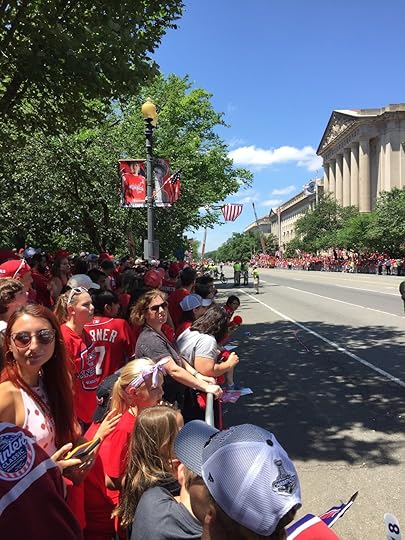
DC looked amazing! The streets were festooned with banners and flags.
[image error]
Um, a lot of people showed up. Most of them were wearing jerseys or t-shirts in the Caps' color, red. Or as we say, they were "rocking the red."
[image error]
Fatima al Ali, a hockey player from the United Arab Emirates, was befriended by Caps alum & former star Peter Bondra and has come to Washington more than once as part of the Capitals' "Hockey Is for Everyone" program.
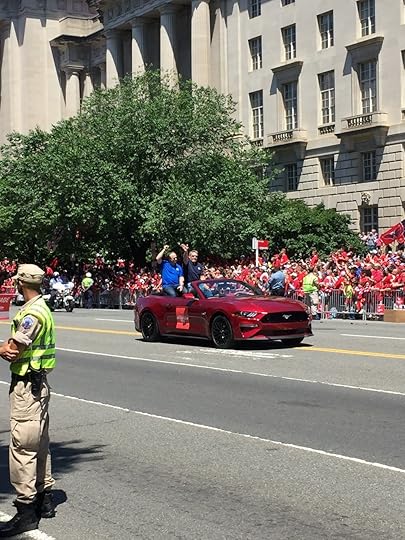
There were Capitals dignitaries, including beloved television play-by-play announcer Joe Beninati and color commentator (and former Caps player) Craig Laughlin. These guys make every broadcast a treat!
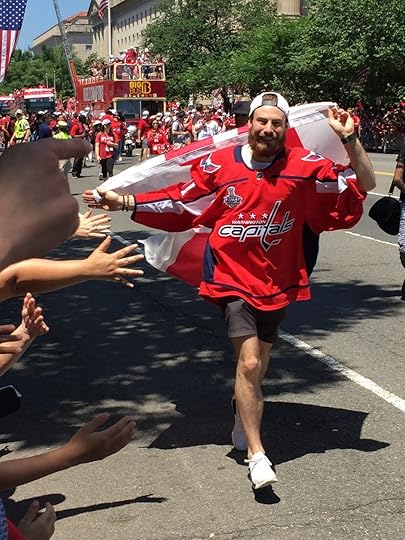
Philipp Grubauer, one the Capitals' goaltenders, hopped off one of the busses and ran a lap draped in the District of Columbia's flag, high-fiving fans.
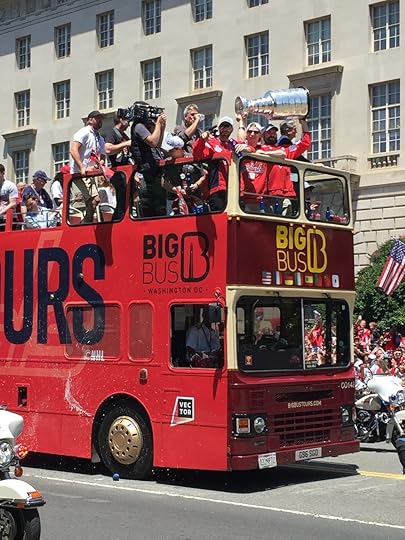
And finally, bringing up the rear, the save-the-best-for-last bus. Seems like we waited forever - you could see the tantalizing gleam of silver when it was still blocks away. Atop the bus: (L to R) Capitals defenseman Brooks Orpik pointing at the crowd, beer in hand; center Nicklas Bäckström; and Captain & winger Alex Ovechkin holding Stanley above his head in iconic fashion. Caps owner Ted Leonsis is visible through the crook of Ovi's arm.
February 21, 2018
The blood spilled at the end of life, and the blood spilled at its beginning
The book's reputation is well-deserved. I'm admittedly not terribly far into my Vietnam War research, but of all the books I've read so far (and also including Burns's and Novick's documentary series The Vietnam War), Dispatches is the first and so far the only account that has haunted me at night. It is riveting, horrifying, beautiful, sad, funny, gruesome, and insightful. In loving, sketchbook fashion, Herr fills even the most briefly encountered grunt with a luminous humanity. He owns up to his own bullshit, and helps us understand.
Reading this afternoon, on page 210 out of 260, I suddenly imagine the rivers of ink spent accounting for all those rivers of blood spilled in that misbegotten war. And then I remember how, when I was writing my (unpublished) first novel (The Bear Wife), I determined to imbue its birth scene with just as much suspense and violence, as much glory and dignity and prominence, as its scenes of Viking battles.
Because those nasty old pragmatic pagans recognized, even if we don't, that you can't spill blood at the end of life unless you've spilled some at its beginning.
November 26, 2017
D1 in DC Wrap-up
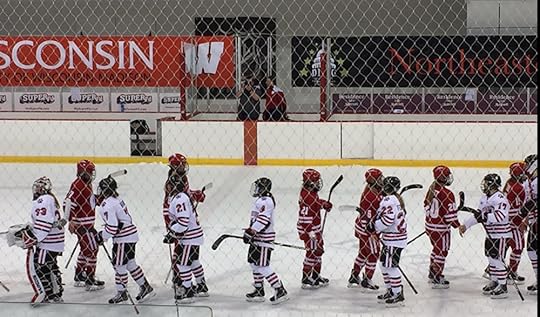
Handshake line, Wisconsin v. Northeastern
In the Washington, DC, area, we are starved for women's hockey - which is why I gladly spent the better part of Thanksgiving weekend at Kettler Capitals Iceplex enjoying four highly entertaining, unusual NCAA Division 1 match-ups. (Unusual because eastern and western teams don't often get the opportunity to meet.)
The D1 in DC tournament, the second such event hosted by the Washington Pride of the Junior Women's Hockey League, included Northeastern and Boston Universities from the Boston area, the University of Wisconsin (Madison), and Minnesota State (Mankato). After engineering an upset of first-ranked Wisconsin on Friday and a decisive win over Minnesota State on Saturday, Northeastern came away the weekend's big winner at 2-0. Wisconsin and Boston University were each 1-1, and Minnesota State 0-2.
The UW Badgers have lost a number of seniors since I saw them play the (sadly) now-defunct University of North Dakota team last January, but their team play was impressive in both Friday's loss and Saturday's win (against Boston University).
All four teams displayed an unwavering focus and a consistency of effort, whether leading or trailing, that I often miss in the professional men's leagues. The games were hard fought and physical, but also showcased plenty of pretty stickhandling and shooting skill. A standout player in my mind was Northeastern's senior Denisa Krizova, not because of the hat-trick she scored in Saturday's game against Minnesota State, but because of her incredibly persistent and courageous hard work down low, below the goal, which I happened to be watching from above - amazing! (As it turns out, she's on the Czech Republic's national team. Look for her in the Olympics!)
At least the fact that this important east-west tournament was not available streaming. He rightly called out the NCAA and the National Hockey League Washington Capitals (Kettler is their practice facility) for overlooking or neglecting the opportunity to make these games available to a larger audience than the 950-or-so fans who were able to squeeze into the venue.
Naturally, I agree. But I would add that, other than the Olympics, the women's games I have seen broadcast, whether streaming or on television, have been disappointing. Not because of the play, but because of the rudimentary fashion in which they are filmed, which makes it difficult or impossible to appreciate the play. Hockey is a fast but nuanced game; proper resources are required to do it justice. The women's game, in particular, which relies on finesse plays rather than on booming hits, will translate particularly well from live to filmed, if done well. I suggest that, in order to help #GrowTheGame, USA Hockey, the NCAA, and the NHL pool their (copious) resources to showcase a number of women's games each season in venues with decent lighting and a reasonable number of professionally-operated cameras.
While we're on the subject, I'm no photographer, and I forgot my camera (a.k.a. my phone) on Saturday. :( But here are a few shots from the weekend.
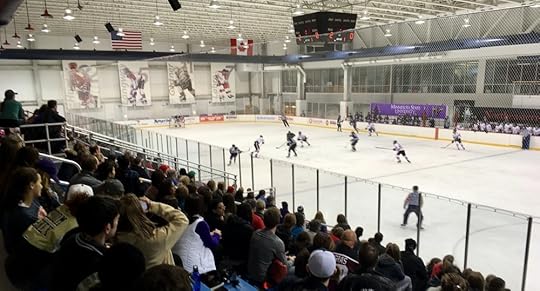
Northeastern v. Minnesota State (photo by Michael Edson)
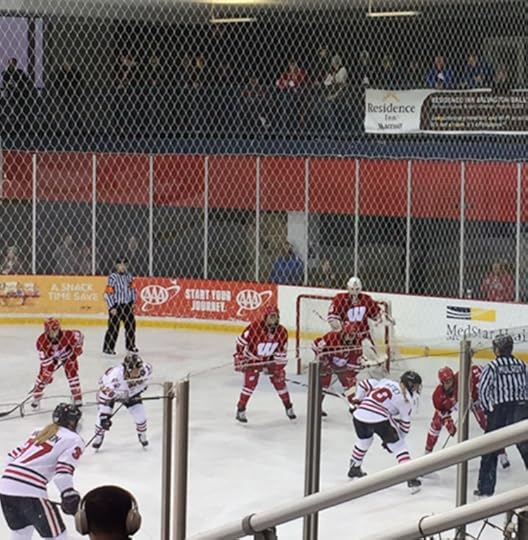
Faceoff
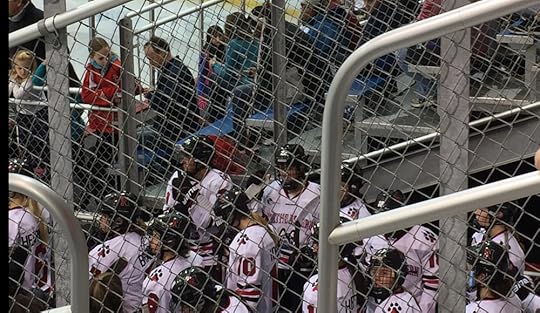
Waiting to take the ice
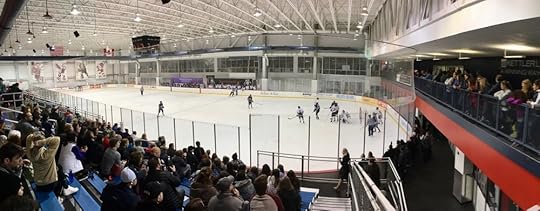
Northeastern v. Minnesota State again (photo by Michael Edson)
October 19, 2017
More thoughts about Agnes: a cost-benefit analysis of womanhood
Some of my friends and acquaintances who've read Seeking the Center have remarked that they "liked Agnes at the end" of the story -- which is interesting to me, because, does that mean they didn't like her at the beginning?
It ties in with a feeling I've had all along about Agnes, and about the way the book ends. I feel sad that, in some ways, at least, she "settles." Sometimes I worry that, maybe, she's not the girl-hero that I initially envisioned, routed for, and loved.
I think I understand what those readers mean, though. Agnes does "grow up." She becomes (visibly) less angry, more "likeable." There are positives there, surely, but there's also a loss, because that anger was not only a driving force in her psyche -- it was righteous.
As a woman -- and this may apply as well to other people who exist outside of society's dominant culture -- your anger doesn't ever get resolved. It doesn't disappear, either. You only "choose" to deal with it in different ways, ways that allow you to "grow up" and "move forward," but that also cause you to bury parts of yourself and your experience.
So, do I "like Agnes at the end" better than I did at the beginning? I don't know. I do think she is more compassionate, more emotionally intelligent. There is an upside to this change, and part of the benefit, I hope, will accrue to her. But what is the cost, not only to her as an individual person with only one life to live, but multiplied out across society? What is the cost of millions of Agneses "growing up" and "moving forward," while leaving their anger unaddressed, unanswered, unresolved?
It makes me think of the famous Langston Hughes poem. What does happen to a dream deferred?
September 30, 2017
Announcing a book giveaway
Hello, friends!
I’m giving away two signed copies of Seeking the Center via Goodreads giveaway in honor of the start of the National Women’s Hockey League season. Sign up to win between now and opening day (October 28). Entrants can be from the US, Canada, Denmark, Finland, Germany, Sweden or Switzerland.
Good luck! :)



